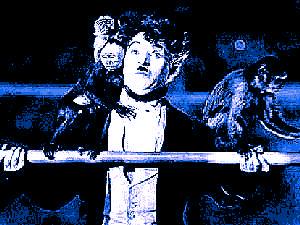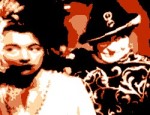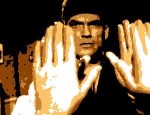Film Review

Chaplin's misgivings for this film may have less to do with its merits and more to do with the fraught circumstances under which it was made. The production coincided with the break-up of Chaplin's marriage with Lita Grey and a well publicised dispute with the federal tax department over non-payment of income tax. This was the most stressful period of Chaplin's life. Gray's lawyers not only sought to ruin Chaplin through an unseemly smear campaign but also attempted to seize his studio assets. With his world collapsing about his ears, Chaplin had no choice but to suspend work on The Circus for eight months.
And this was not the end of Chaplin's troubles. The Circus was plagued with bad luck from the outset. Before shooting began, the tent within which most of the action was to have taken place was destroyed by gales. The first four weeks of filming was lost when the film stock was ruined in the print laboratory. Nine months into the shoot, a fire broke out in the studio, destroying most of the sets and props. And, for the last sequence, the entire circus train was stolen by a party of students shortly after it had been towed to the location. It was a miracle that Chaplin ever completed the film. He must have felt the project was jinxed from the word go.
The starting point for The Circus was the scene (one of the greatest set pieces of any Chaplin film) in which the Little Tramp is attacked by several malicious monkeys whilst crossing a tightrope, high over a circus ring. Chaplin may have been inspired by his contemporary Harold Lloyd, who specialised in this kind of suspense comedy that combined dare devil stunts with slapstick. The rest of the story was developed from this one scene, mostly through improvisation and experimentation, just as Chaplin had done in the majority of his preceding films. Owing to to several delays in its production and Chaplin's perfectionism, the film took two years to complete.
Although The Circus is far less well known than Chaplin's other full-length films, it contains some of his funniest and most inventive gags. These include the scene in which the Tramp attempts to escape from an over-enthusiastic policeman in a hall of mirrors, another scene in which the Tramp imitates an automaton to evade capture and the sequence in which Chaplin imaginatively uses double exposure to show the Tramp imagining himself kicking his rival in the posterior. Of course, the high point is the tightrope scene, in which the Tramp struggles to fend off a hoard of monkeys (who seem strangely obsessed with removing his trousers) whilst he tries to avoid falling to his death from a tightrope.
Having languished in virtual obscurity for four decades, The Circus was finally re-released in 1970. Chaplin not only composed a score especially for the film but also wrote a title song, which he was persuaded to sing. Underrated both by Chaplin himself and by the critics, The Circus surely deserves a fresh appraisal. Unhampered by the over-egged sentimentality of Chaplin's later films and evoking the spontaneity and fun of his earlier work, this is surely one of his most entertaining and rewarding films.
© James Travers 2009
The above content is owned by frenchfilms.org and must not be copied.
Film Synopsis
Mistaken for a pickpocket, a tramp is pursued by a policeman through a fairground and takes refuge in a circus big top. When he inadvertently makes the audience roar with laughter, the tramp is immediately engaged by the circus proprietor. It soon becomes apparent that the tramp has no future as a clown so he ends up working as a prop man. Again, a chance occurrence propels the tramp back into the circus ring, and, again, he brings the house down through his ineptitude. Unknowingly, the tramp becomes the circus's star attraction, although he is more interested in his boss's daughter than in fame. A blossoming romance is thwarted when the object of the tramp's feckless fancy falls for another man, the circus's new tightrope walker. Determined to win back the girl that he loves, the tramp decides that he too will become a tightrope artiste, unaware of the hazards which this may entail...© James Travers
The above content is owned by frenchfilms.org and must not be copied.
Similar Films
Here are some other films you may enjoy watching:- Claudine à l'école (1937)
- Le Président Haudecoeur (1940)
- Le Briseur de chaînes (1941)
- Paradis perdu (1940)
- Jean de la Lune (1931)
Other related links:
Film Credits
- Director: Charles Chaplin
- Script: Charles Chaplin
- Cinematographer: Roland Totheroh
- Music: Charles Chaplin
- Cast: Al Ernest Garcia (The Circus Proprietor and Ring Master), Merna Kennedy (Merna), Harry Crocker (Rex), George Davis (Professor Bosco), Henry Bergman (An Old Clown), Tiny Sandford (The Head Property Man), John Rand (An Assistant Property Man), Steve Murphy (A Pickpocket), Charles Chaplin (A Tramp), Albert Austin (Clown), Charles A. Bachman (Cop), Eugene Barry (Cop), Jack Bernard (Man in Circus Audience), Stanley Blystone (Cop), Heinie Conklin (Clown), Bill Knight (Cop), Toraichi Kono (Man in Circus Audience), H.L. Kyle (Man in Circus Audience), Betty Morrissey (The Vanishing Lady), L.J. O'Connor (Cop)
- Country: USA
- Language: None
- Support: Black and White / Silent
- Runtime: 71 min
French cinema during the Nazi Occupation

The very best fantasy films in French cinema

The very best of French film comedy
